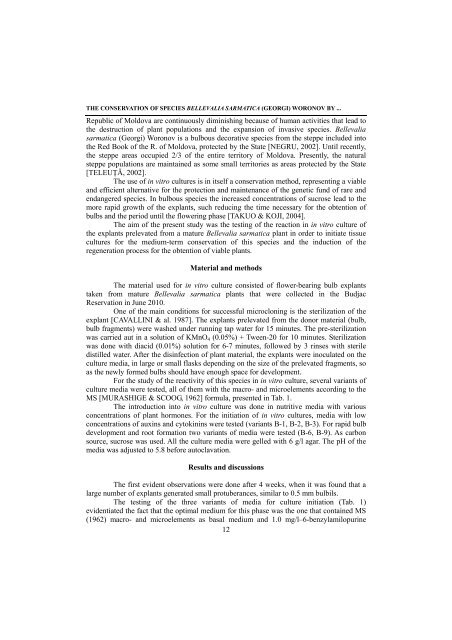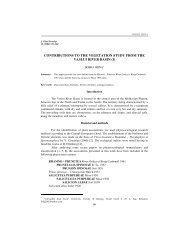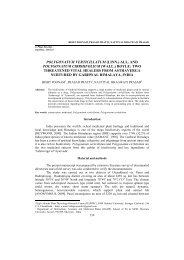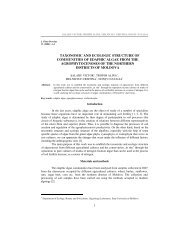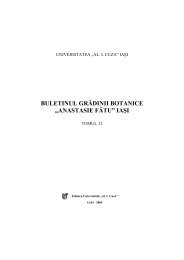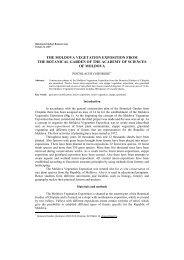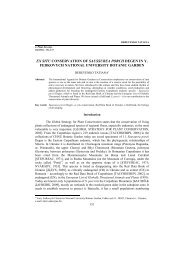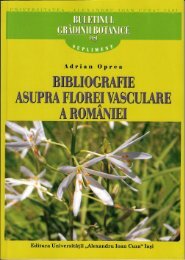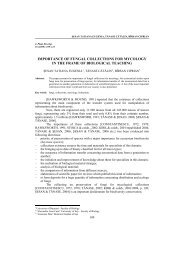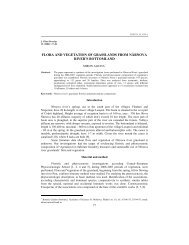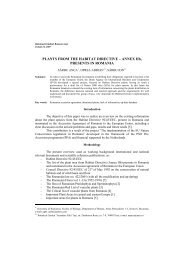the conservation of species bellevalia sarmatica - Journal of Plant ...
the conservation of species bellevalia sarmatica - Journal of Plant ...
the conservation of species bellevalia sarmatica - Journal of Plant ...
Create successful ePaper yourself
Turn your PDF publications into a flip-book with our unique Google optimized e-Paper software.
THE CONSERVATION OF SPECIES BELLEVALIA SARMATICA (GEORGI) WORONOV BY ...<br />
Republic <strong>of</strong> Moldova are continuously diminishing because <strong>of</strong> human activities that lead to<br />
<strong>the</strong> destruction <strong>of</strong> plant populations and <strong>the</strong> expansion <strong>of</strong> invasive <strong>species</strong>. Bellevalia<br />
<strong>sarmatica</strong> (Georgi) Woronov is a bulbous decorative <strong>species</strong> from <strong>the</strong> steppe included into<br />
<strong>the</strong> Red Book <strong>of</strong> <strong>the</strong> R. <strong>of</strong> Moldova, protected by <strong>the</strong> State [NEGRU, 2002]. Until recently,<br />
<strong>the</strong> steppe areas occupied 2/3 <strong>of</strong> <strong>the</strong> entire territory <strong>of</strong> Moldova. Presently, <strong>the</strong> natural<br />
steppe populations are maintained as some small territories as areas protected by <strong>the</strong> State<br />
[TELEUŢĂ, 2002].<br />
The use <strong>of</strong> in vitro cultures is in itself a <strong>conservation</strong> method, representing a viable<br />
and efficient alternative for <strong>the</strong> protection and maintenance <strong>of</strong> <strong>the</strong> genetic fund <strong>of</strong> rare and<br />
endangered <strong>species</strong>. In bulbous <strong>species</strong> <strong>the</strong> increased concentrations <strong>of</strong> sucrose lead to <strong>the</strong><br />
more rapid growth <strong>of</strong> <strong>the</strong> explants, such reducing <strong>the</strong> time necessary for <strong>the</strong> obtention <strong>of</strong><br />
bulbs and <strong>the</strong> period until <strong>the</strong> flowering phase [TAKUO & KOJI, 2004].<br />
The aim <strong>of</strong> <strong>the</strong> present study was <strong>the</strong> testing <strong>of</strong> <strong>the</strong> reaction in in vitro culture <strong>of</strong><br />
<strong>the</strong> explants prelevated from a mature Bellevalia <strong>sarmatica</strong> plant in order to initiate tissue<br />
cultures for <strong>the</strong> medium-term <strong>conservation</strong> <strong>of</strong> this <strong>species</strong> and <strong>the</strong> induction <strong>of</strong> <strong>the</strong><br />
regeneration process for <strong>the</strong> obtention <strong>of</strong> viable plants.<br />
Material and methods<br />
The material used for in vitro culture consisted <strong>of</strong> flower-bearing bulb explants<br />
taken from mature Bellevalia <strong>sarmatica</strong> plants that were collected in <strong>the</strong> Budjac<br />
Reservation in June 2010.<br />
One <strong>of</strong> <strong>the</strong> main conditions for successful microcloning is <strong>the</strong> sterilization <strong>of</strong> <strong>the</strong><br />
explant [CAVALLINI & al. 1987]. The explants prelevated from <strong>the</strong> donor material (bulb,<br />
bulb fragments) were washed under running tap water for 15 minutes. The pre-sterilization<br />
was carried aut in a solution <strong>of</strong> KMnO4 (0.05%) + Tween-20 for 10 minutes. Sterilization<br />
was done with diacid (0.01%) solution for 6-7 minutes, followed by 3 rinses with sterile<br />
distilled water. After <strong>the</strong> disinfection <strong>of</strong> plant material, <strong>the</strong> explants were inoculated on <strong>the</strong><br />
culture media, in large or small flasks depending on <strong>the</strong> size <strong>of</strong> <strong>the</strong> prelevated fragments, so<br />
as <strong>the</strong> newly formed bulbs should have enough space for development.<br />
For <strong>the</strong> study <strong>of</strong> <strong>the</strong> reactivity <strong>of</strong> this <strong>species</strong> in in vitro culture, several variants <strong>of</strong><br />
culture media were tested, all <strong>of</strong> <strong>the</strong>m with <strong>the</strong> macro- and microelements according to <strong>the</strong><br />
MS [MURASHIGE & SCOOG, 1962] formula, presented in Tab. 1.<br />
The introduction into in vitro culture was done in nutritive media with various<br />
concentrations <strong>of</strong> plant hormones. For <strong>the</strong> initiation <strong>of</strong> in vitro cultures, media with low<br />
concentrations <strong>of</strong> auxins and cytokinins were tested (variants B-1, B-2, B-3). For rapid bulb<br />
development and root formation two variants <strong>of</strong> media were tested (B-6, B-9). As carbon<br />
source, sucrose was used. All <strong>the</strong> culture media were gelled with 6 g/l agar. The pH <strong>of</strong> <strong>the</strong><br />
media was adjusted to 5.8 before autoclavation.<br />
Results and discussions<br />
The first evident observations were done after 4 weeks, when it was found that a<br />
large number <strong>of</strong> explants generated small protuberances, similar to 0.5 mm bulbils.<br />
The testing <strong>of</strong> <strong>the</strong> three variants <strong>of</strong> media for culture initiation (Tab. 1)<br />
evidentiated <strong>the</strong> fact that <strong>the</strong> optimal medium for this phase was <strong>the</strong> one that contained MS<br />
(1962) macro- and microelements as basal medium and 1.0 mg/l–6-benzylamilopurine<br />
12


